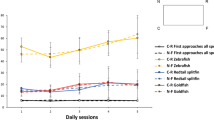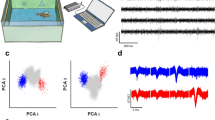Abstract
Research on spatial cognition has focused on how animals encode the horizontal component of space. However, most animals travel vertically within their environments, particularly those that fly or swim. Pelagic fish move with six degrees of freedom and must integrate these components to navigate accurately—how do they do this? Using an assay based on associative learning of the vertical and horizontal components of space within a rotating Y-maze, we found that fish (Astyanax fasciatus) learned and remembered information from both horizontal and vertical axes when they were presented either separately or as an integrated three-dimensional unit. When information from the two components conflicted, the fish used the previously learned vertical information in preference to the horizontal. This not only demonstrates that the horizontal and vertical components are stored separately in the fishes’ representation of space (simplifying the problem of 3D navigation), but also suggests that the vertical axis contains particularly salient spatial cues—presumably including hydrostatic pressure. To explore this latter possibility, we developed a physical theoretical model that shows how fish could determine their absolute depth using pressure. We next considered full volumetric spatial cognition. Astyanax were trained to swim towards a reward in a Y-maze that could be rotated, before the arms were removed during probe trials. The subjects were tracked in three dimensions as they swam freely through the surrounding cubic tank. The results revealed that fish are able to accurately encode metric information in a volume, and that the error accrued in the horizontal and vertical axes whilst swimming in probe trials was similar. Together, these experiments demonstrate that unlike in surface-bound rats, the vertical component of the representation of space is vitally important to fishes. We hypothesise that the representation of space in the brain of vertebrates could ultimately be shaped by the number of the degrees of freedom of movement that binds the navigating animal.




Similar content being viewed by others
References
Bone Q, Moore RH (2008) Biology of fishes, 3rd edn. Taylor & Francis Group, Abingdon
Grobety MC, Schenk F (1992) Spatial-learning in a 3-dimensional maze. Anim Behav 43:1011–1020
Hayman R, Verriotis MA, Jovalekic A, Fenton AA, Jeffery KJ (2011) Anisotropic encoding of three-dimensional space by place cells and grid cells. Nat Neuro 14:1182–1244
Holbrook RI, Burt de Perera T (2009) Separation of vertical and horizontal information simplifies the problem of navigating through a three-dimensional environment in fish. Anim Behav 78:241–245
Holbrook RI, Burt de Perera T (2011a) Three-dimensional spatial cognition: information in the vertical dimension overrides information from the horizontal. Anim Cogn 14:613–619
Holbrook RI, Burt de Perera T (2011b) Fish navigation in the vertical dimension: can fish use hydrostatic pressure to determine depth? Fish Fish 12:370–379
Jovalekic A, Hayman R, Becares N, Reid H, Thomas G, Wilson J, Jeffery K (2011) Horizontal biases in rats’ use of three-dimensional space. Behav Brain Res 222:279–288
Taylor GK, Holbrook RI, Burt de Perera T (2010) Fractional rate of change of swim-bladder volume is reliably related to absolute depth during vertical displacements in teleost fish. J Roy Soc Interface 7:1379–1382
Ulanovsky N (2011) Neuroscience: how is three-dimensional space encoded in the brain? Curr Biol 21:R886–R888
Acknowledgments
This research was funded by a Biotechnology and Biological Sciences Research Council grant (BB/H01103X/1).
Author information
Authors and Affiliations
Corresponding author
Rights and permissions
About this article
Cite this article
Burt de Perera, T., Holbrook, R.I. Three-dimensional spatial representation in freely swimming fish. Cogn Process 13 (Suppl 1), 107–111 (2012). https://doi.org/10.1007/s10339-012-0473-9
Published:
Issue Date:
DOI: https://doi.org/10.1007/s10339-012-0473-9




